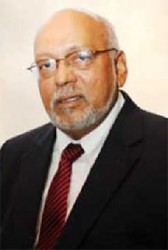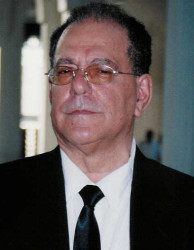Amid ongoing concerns about the problematic operations of the Skeldon Sugar Factory which has cost millions to fix since its construction, former President Donald Ramotar says that price was the most important issue in awarding the contract, a point that sugar industry expert Tony Vieira has disputed.
“When GuySuCo invited tenders for the construction of the new factory at Skeldon, there were three bidders – a Chinese, an Indian and a Japanese company. The Japanese company placed a very high bid. The lowest bid was from the Chinese company. Before an award was made, Booker Tate (which was managing GuySuCo at the time) was awarded the contract to be the consulting engineers for GuySuCo. The Board felt that it needed to be advised by competent technical professionals. The consulting engineers worked along with the Board at every stage in this process,” Ramotar wrote in a letter to Stabroek News.
Walchandnagar Industries Limited (WIL) of India and the China National Technical Import and Export Corporation (CNTIC) had bid for the Skeldon Sugar Modernisation Project. CNTIC was eventually awarded the contract. “These consultants also visited both China and India where they held talks with both the companies which tendered. They reported to the Board that all of the bidders were capable of building the new factory, and that they were ready to work with whichever company was chosen to execute the work. Clearly, with that advice from the consultants, price then became the most important issue to base the decision on. The Board went for the lowest bidder,” Ramotar declared.


Vieira however accused Ramotar of falsehoods and distortion. “I maintain that Walchandnagar’s bid for the parts of the factory was the lowest. … perhaps [Ramotar] is not aware that there were invitations for 4 tenders for the new factory SWR 1, 2, 3, 4. If memory serves and I refuse to research this to respond to the diatribe written by Mr Ramotar, SWR 1 was the contract to actually build the factory, SWR 2 was for the milling and diffuser sections; SWR 3 was for the boiling house and SWR 4 was for the power house and co-generation.
Walchandnagar bid on SWR 2, 3, 4 but did not bid to build the factory, since they alleged that [Booker] Tate had not given them the geotechnical information which would allow them to build a proper foundation for the factory,” Vieira wrote in response.
“[Then president Bharrat] Jagdeo then told them that they had two weeks to come up with a price, since the Chinese had already bid with the documents they had been given by GuySuCo but Walchandnagar stuck to their principles and lost the contract,” he said.
Ramotar also accused Vieira of peddling inaccuracies and questioned the now GuySuCo director’s statement that Walchandnagar had offered to sell GuySuCo parts for the Skeldon Estate. “This must be a mistake, since we are talking about a new factory. Mr Vieira went on to say in his letter that the said company had the lowest bid, but the previous administration had given the contract to a Chinese company at a higher price,” Ramotar said.
“These statements are absolutely incorrect; this was not the case,” he declared.
According to Ramotar, who was a director of GuySuCo at the time, the project was awarded as a turnkey project and went to the lowest bidder, CNTIC. “During the construction process, the Board was briefed at every meeting by its consultants. No payments were made to the company without clearance from the Booker Tate professionals. I can even recall that at one point, the then government took a while to reappoint the Board and management, therefore, had to bear the responsibility to oversee the project. The Booker Tate consultants were so confident about the success of the project that they allowed the company to send its workers home on holiday,” he wrote.
Full accredited

Vieira denied that he was making false accusations and noted that Walchandnagar only bid for three components and offered to sell the parts for the factory. “Walchandnagar is a fully accredited sugar factory manufacturer, which told me that they had built 40 turnkey factories like the Skeldon factory before with a through-put of 350 tons cane per hour. The Chinese company he and Mr Jagdeo ended up giving the project to, do not. It is why, confirmed by staff at Skeldon, large components from one part of the factory do not match those in other sections and had to be modified when the factory was being built,” Vieira declared
“More than one time I have relayed this information to the public and only now has Mr Ramotar woken up after slumbering through more than two decades … to read my accusations,” he said, emphasising that he was responding in his private capacity and not as a director of GuySuCo.
Vieira also took issue with Ramotar’s statement that during the construction process “the board was briefed at every meeting by its consultants and no payments were ever made to the Chinese construction company without clearance from the Booker Tate professionals.”
He said that that he found this strange in view of court documents filed on September 23, 2012 by Dr Nanda Gopaul who said that he was Chairman of GuySuCo between January 2009 and December 2011, in the legal action involving GuySuCo and Booker Tate over outstanding fees to Booker Tate.
Vieira pointed out that in his pleadings, Gopaul alleged a number of transgressions were committed by Booker Tate.
Vieira said that, according to the document, during the land development programme at Skeldon, Booker Tate failed to install any drainage facilities in time, thereby flooding the entire Skeldon cultivation for years and depending only on existing drainage facilities which were woefully inadequate, with disastrous results to Skeldon which lost $468 million.
There were yield losses due to the wrong choice of field layout, ie ridge and furrow rather than the three-bed system conversion system and in the process 855 hectares were so converted and cane and sugar losses in doing this over the five years from the time they did this to the date of his pleadings the corporation lost $1.701.6 billion, he said.
“Only after a total of 1855 hectares was converted to ridge and furrow rather than the broad bed design it was re-done to the wide bed design which incurred a further loss of $440.7 million,” he said.
He also pointed out that Gopaul alleged that two bridges in the new land development of the Skeldon cultivation were not only badly placed but were badly constructed and to rectify the problem the corporation was forced to spend $27 million. In addition, an all-weather road constructed by Booker Tate at a cost of $13 million which was supposed to last five years lasted less than one year, he wrote.
According to Vieira, in the case of the link creek canal, which was supposed to be used to transport cane from the farmers’ areas to the factory, Booker Tate neglected to install a sluice which the corporation will now have to build at a cost of an extra $60 million.
Old factory
“In 2008 Tate advised the board to stop the old factory and start using the new factory and according to Dr Gopaul the decision was disastrous the total losses were estimated at US$3,450,000,” he wrote.
In 2009, Booker Tate again advised that the old factory be taken out of operation and the new factory be put on line; the disaster that resulted according to Gopaul was US$1,568,000.
Vieira wrote that Booker Tate gave permission for a bore hole well costing $56 million and the project failed costing the corporation US$280,000.
He said that the new factory was designed to operate at 350 tons cane per hour, but the punt dumper system which was installed by the Chinese under the supervision of Booker Tate was found to be capable of delivering only 299 tons cane per hour. (For several years grinding has been as low as 185 tonnes per hour.) The total loss to GuySuCo so far has been US$175,000. “Mr Ramotar was still sleeping and why should he not? Tate were by his own admission in his letter an excellent and highly professional operation outfit in his assessment,” he wrote.
Vieira said that more than 400 steam valves approved by Booker Tate were found to be wrong and had to be replaced and also caused losses in the boiling house – a total loss of US$825,000.
“The diffuser design approved by Tate was not suitable for that purpose resulting in an undisclosed amount of losses… Further losses, according to this sworn evidence by Nanda Gopaul, stated that there were design flaws in the 1. Bagasse Ploughs 2. Evaporator CIP system 3. Shredder motor starting system 4. Bagasse conveyors, 5. Mill rolls and 6. Piping. A loss to the defendant GuySuCo of US$1 million,” he wrote.
Booker Tate approved the design of the factory without a mud removal system (OC filtre); this had to be rectified by bringing the filtre from the old factory to be installed in the new one. This oversight cost GuySuCo US$825,000, he said.
“These losses in the factory cost the corporation US$8.72M. These are only the losses in the factory; remember that there were losses in the fields as well from what GuySuCo alleged were due to the gross incompetence of [Booker] Tate. When I say that Walchandnagar wanted a better analysis of the soil on which the factory was to be built. This was the single biggest disaster in the history of this country presided over by the PPP,” Vieira declared.
He said that that the members of the board at the time have to be asked why it happened. “This project was ill conceived and was doomed to failure in view of the loss of the sugar preferential prices which we knew about as early as 2003, even if we did not give the contract to the Chinese to build it, resulting in these disasters,” Vieira declared.
Over the years, Booker Tate has not addressed allegations relating to its stewardship and oversight of the Skeldon Sugar Modernisation Project.





